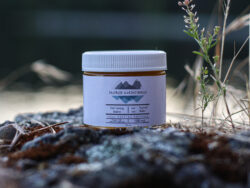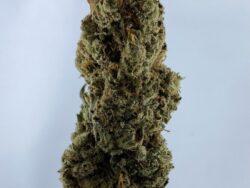Description
Lion’s Claw is a 40% indica/40% sativa/20% ruderalis created through crossing the classic Lion’s Gate X Mexican Cultivar strains. Our organic sungrown flower harvested in the middle of August 2024. Its smell is intoxicating, the bud is super sticky and covered with trichomes. This is terpy delcious outdoor. It is a great choice for a lazy afternoon or evening when you want to kick back before you get to sleep. The high will settle in quickly, lifting your mind into a place of happiness and ease. A light physical tingle comes next, sinking into your body with a sense of deep relaxation that soon has you feeling super sedative and ready to get to sleep. Lion’s Claw could be a good choice to provide relief for a variety of conditions including chronic pain, depression, insomnia, cramps or muscle spasms and chronic stress.
Even though it is outdoor sungrown flower the bud packs a punch and is recommended for those with a higher tolerance. We would call the high “a solid cannabis high” – just like cannabis should feel. Not as “fuzzy” as some strains, but definitely on the relaxed side. “If you just take a couple hits the buzz is very pleasant, and you’ll still feel like getting up and doing stuff or getting into a creative project.”
Farm: Hope Hill
Benefits of sungrown?
Complements the plant’s natural life cycle. For millions of years, plants that undergo photosynthesis have evolved and flourished under the rays of the sun. Scientists report that cannabinoid and terpene production is greatest in ambient light. Natural light is much more complex than what even the best grow lights can mimic. Unlike indoor plants, outdoor cannabis is exposed to a full spectrum of light from the sun, moon, and stars. Outdoor cultivation also enables natural airflow and ventilation; no electric fans are necessary. It’s impossible to duplicate nature’s supreme design when growing cannabis indoors.
Low carbon footprint and lower costs. Sungrown cannabis requires far fewer resources and is less expensive to produce than plants grown indoors. Sungrown uses the natural environment to fuel its growth, and it does not require artificial, high-intensity lighting. Compared to indoor grown cannabis, sungrown plants typically require less soil amendments, fertilizers, pesticides and fungicides. Indoor power usage and water usage is very resource consumptive. Evan Mills reports in Energy Policy that an average kilo of cannabis grown indoors is associated with 4600 kilograms of carbon dioxide emissions into the atmosphere. “From the perspective of individual consumers, a single Cannabis cigarette represents 1.5 kg (3 pounds) of CO2 emissions… The energy to produce one marijuana cigarette would also produce 18 pints of beer,” according to Mills, who adds: “There is little, if any, indication that public policymakers have incorporated energy and environmental considerations into their deliberations on cannabis production and use.” Although indoor growers can utilize sustainable energy solutions such as solar power, sungrown cannabis, with its much lower carbon footprint, will always prevail in the sustainability competition. Jackfruit
Ecology and resiliency. Acclimated to local conditions, unique landrace varietals native to specific bioregions (Acapulco Gold, Panama Red, etc.) have adapted to deal with local pests and other threats. Because outdoor crops are part of the ecosystem, the plant interacts with the elements and this helps to build flexibility and resistance to temperature fluctuations and potential attacks. Healthy plants are less susceptible to the invasion of mold, mildew, and predators in general. Organic farming methods can preserve and enhance the complex biota of the earth’s soil in a way that retains carbon and helps to offset global warming. When growing outdoors, a farmer has more liberties to implement sustainable methods of cultivation, such as the permacultural techniques of companion planting. These methods utilize various natural techniques to sustain a thriving ecosystem: intercropping (with plants that compliment cannabis), planting ground cover (which keeps in water and nutrients), and introducing beneficial bugs. Companion planting avoids growing in a monoculture and brings in a variety of plant species to implement complementary natural pest management which contributes to a diverse, healthy ecosystem. This is possible to some degree with indoor growing, but the opportunities for permaculture techniques are limited indoors. Jackfruit
Therapeutic horticulture. Cultivators who work with sungrown plants get a good dose of nature therapy just by being outdoors. That’s especially important in a society where people are generally disconnected from their natural environment; getting outside can help to balance this deficit. An essential source of Vitamin D and much more, sunlight is intrinsically therapeutic. According to an October 2016 study in the Journal of Internal Medicine, sunlight deficiency can be as harmful to human health as cigarette smoking. Outdoor cannabis farmers also benefit from bathing in the symphony of smells and organic aromas indigenous to the local terroir. Plants communicate with each other and their cohabitants, especially insects, by releasing odiferous compounds known as terpenes in response to environmental stressors. Some plant smells attract beneficial bugs; others repel predators. It’s our good fortune that many of the same compounds plants generate under stress have medicinal properties that help human beings cope with stress. Jackfrui
What’s the difference between our organically grown and non organically grown Cannabis flowers? Cert Organic means the strain was grown following the same principles used to grow your organic vegetables. As such only certified organic (such as OMRI) nutrients, fungus and pest control products are used in the farming of our organic cannabis flowers. Non-organic in relation to our cannabis products just means rthat the bud was grown using specialized cannabis fertilizers which are not omri approved (for more on difference between organic and non-organic fertilizers see description below. Because we are growing medicinal cannabis we do not use any chemical fungicides or pesticides or anything that could cause harm to our members.
What Is The Difference Between Organic and Non-Organic Fertilizers? Organic Fertilizers are derived from organic sources. In other words, dead and decayed plants, animal manures, fish parts etc… With non-Organic fertilizers or mineral fertilizers, the nutrients are inorganic salts, obtained by extraction and/or physical and chemical processes. The three primary plant nutrients are nitrogen, phosphorus and potassium.
The cannabis we offer for mail order delivery is grown in small-batches by passionate growers. Buy weed online directly from the farmers, and get some of the best mail order marijuana in Canada. “Farm to bowl”.
Dried Cannabis flowers are an agricultural product where conditions for production are constantly changing. Therefore there will always be some variation between harvests and batches. The bud you receive may not be exactly as illustrated. The displayed THC and CBD ranges are estimates. Check the “Batch Quality” rating for our grower and budtenders rating for the current batch.
If you have any questions about our mail-order cannabis products, do not hesitate to send us a message through contact page or visit our Instagram page.






